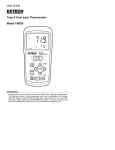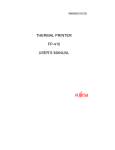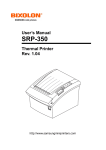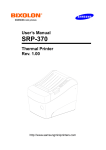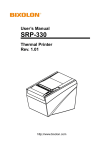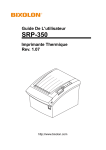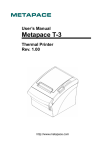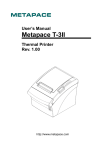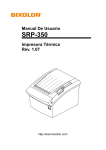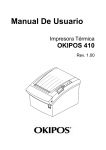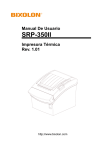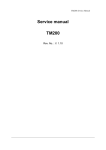Download TM200 USER'S MANUAL
Transcript
for Thermal Receipt Printer TM200 USER’S MANUAL User’s Manual Table of Contents Introduction Introduction .................................................... ii CHAPTER 1 Setting Up the Printer Unpacking....................................................................... 1-1 Connecting Cable ........................................................... 1-2 Installing or Replacing the Paper Roll ............................ 1-5 Adjustments and Settings............................................... 1-8 Using the Printer ............................................................. 1-9 CHAPTER 2 Reference Information Printing Specifications ................................................... 3-1 Paper Specifications...................................................... 3-3 Electrical Characteristics ............................................... 3-3 Environmental Conditions ............................................. 3-4 CHAPTER 4 The printers have the following features: Printing High-speed printing: 180 mm/sec, 60 lines /sec maximum. The Self Test The Self Test................................................................... 2-1 CHAPTER 3 TM200 series printers are high-quality POS printers, and design for use with electronic instruments such as system ECR, POS, banking equipment, computer peripheral equipments. Low-noise thermal printing. Application Software ® Command protocol is based on the ESC / POS standard. Various layouts are possible by using page mode. Characters can be scaled up to 4 times as large as standard size. Troubleshooting General questions ......................................................... 4-1 Printing questions.......................................................... 4-1 Cleaning the print head ................................................. 4-3 Auto cutter questions .................................................... 4-4 Hexadecimal Dump............................................................... 4-6 Bar code printing is possible by using a bar code command. i.e. Bar codes can be printed both in vertical direction, and in the horizontal direction. Repeated operations and copy printing are possible by using macro APPENDIXES Appendix A DIP Switch and Paper Near End Settings..................... A-1 Appendix B Connectors .................................................................... A-7 definitions. Character font size (12 x 24 font or 9 x 17 font) can be selected using a command. MU04001D i ii Printer Handling Chapter 1. Setting Up the Printer Easy drop-in paper roll loading Unpacking An auto-cutter is standard The illustration below shows the items should included for the standard of TM200 printer package. If any items are damaged or missing, please contact with your dealer for assistance. Support “partial” and “full” cutter. Printer allows easy maintenance for tasks such as head cleaning Three different print densities can be selected by DIP switches. The built-in interface provides control capability for two drawers. Interface: RS-232, Parallel Port, USB interface. Paper roll AC adapter Power cord Options and Accessories TM200 power supply unit Communication cable RS-232 interface board Parallel interface board User’s manual USB interface board Printer Standard cable cover set (included wall mounting bracket) Top waterproof cover Thermal paper reel Communication cable iii Windows driver 1-1 Connecting the Cables Connecting the drawer You can connect up to three cables to the printer. They all connect to the connector panel on the back of the printer, which is shown below: WARNING: Use a drawer that matches the printer specification. Using an improper drawer may damage the drawer as well as the printer. CAUTION: Do not connect a telephone line to the drawer kick-out connector; otherwise the printer and the telephone line may be damaged. Plug the drawer cable into the drawer kick-out connector on the back of the printer next to the power supply connector. Interface Drawer kick-out Power supply Power supply Notes: There is a caution label above the drawer kick-out connector. Depending on the interface installed, the interface connector on your printer may look different from the one illustrated. Before connecting any of the cables, make sure that both the printer and the computer are turned off. Connecting the computer You need an appropriate interface cable. 1. 2. Plug the cable connector securely into the printer’s interface connector. If the printer has a serial interface, tighten the screws on both sides of the cable connector. If the printer has a parallel interface, squeeze the wire clip on the printer together until they lock in place on both sides of the connector. 3. Attach the other end of the cable to the computer. 1-2 1-3 Connecting the Power Supply Installing or Replacing the Paper Roll WARNING: Notes: Be sure to use paper rolls that meet the specifications. Do not use paper rolls that have the paper glued to the core because the printer cannot detect the paper end correctly. Make sure that you use the optional +24V power supply or equivalent for your printer. Using an incorrect power supply may caused fire or electrical shock. 1. Make sure that the printer is not receiving data; otherwise, data may be lost. 2. Open the paper roll cover by pressing the cover-open button. If the cover-open button will not open the cover, see page 4-3 or 4-5 in Troubleshooting. CAUTION: When connecting or disconnecting the power supply from the printer, make sure that the power supply is not plugged into an electrical outlet. Otherwise you may damage the power supply or the printer. If the power supply’s rated voltage and your outlet’s voltage do not match, contact your dealer for assistance. Do not plug in the power cord. Otherwise, you may damage the power supply or the printer. 1. Make sure that the printer’s power switch is turned off, and the power supply’s power cord is unplugged from the electrical outlet. 2. Check the label on the power supply to make sure that the voltage required by the power supply matches that of your electrical outlet. 3. Plug in the power supply’s cable as shown below. Notice that the flat side of the plug faces down. Notes: Do not open the print cover while the printer is operating. This may damage the printer. 3. Remove the used paper roll core if there is one. Notes: To remove the DC cable connector, make sure that the power supply’s power cord is unplugged; then grasp the connector at the arrow and pull it straight out. 1-4 1-5 4. Insert the paper roll as shown. 6. Pull out a small amount of paper, as shown. Then close the cover. 5. Be sure to note the correct direction that the paper comes off the roll. 1-6 1-7 Adjustments and Settings Using the Printer The TM200 Series are set up at the factory to be appropriate for almost all users. It does, however, offer some settings for users with special requirements. You can control the basic paper feeding operations of the printer with the button on the control panel. The indicator lights help you monitor the printer’s status. It has DIP switches that allow you to change communication settings, such as handshaking and parity check, as well as print density. Control Panel The TM200 Series also have a near-end sensor for the paper. This can give you a warning when the paper is almost out. If you find that there is not enough paper remaining on the roll when the near-end detector is triggered, you can change the near-end sensor setting. POWER See Appendix A if you need to make any of these changes. FEED ERROR PAPER Button The button can be disabled by the ESC c 5 command. Press the FEED button once to advance paper one line. You can also hold down the FEED button to feed paper continuously. Panel lights POWER The POWER light is on whenever the printer is on. ERROR This indicates an error. See Chapter 4 for information on what to do when this light comes on. PAPPER This light indicates the near end of the paper roll. Install a new paper roll and the printer will continue printing. 1-8 1-9 Indicator on Control Panel POWER ERROR Chapter 2. The self test The self test lets you know if your printer is operating properly. It checks the control circuits, printer mechanisms, print quality, ROM version, and DIP switch settings. Status Description Power light “On” Printer power is on. Power light “Off” Power cable is not connected with printer Status Description Running the self test ERROR light is “On” (not blinking), and heard beeper sound Turn off the printer and check if cutter was seized. 1. Make sure the printer is turned off and the printer covers are closed properly. This test is independent of any other equipment or software. PAPER FEED ERROR light is ”Blinking“ 2. Make sure a paper roll has been installed properly. Make sure that the printer cover is properly closed. Press the printer cover audibly clicks into place. ERROR light is Off, but noting is printed Try to run the self test to check that the printer works properly. See the self test instructions in Chapter 1. Status Description PAPER light is “On“ There is a paper roll inside the printer. PAPER “Red” light is “On” The paper roll is near end. PAPER “Red” light is “Blinking“ The paper roll is not installed or is at the end. Install a new paper roll. See Chapter 1 for instructions. PAPER light is “Off“ If power is connected, and PAPER light still Off, please turn off power, and check if printer on programming mode. 1-10 3. While holding down the FEED button, turn on the printer using the switch on the front of the printer to begin the self test. The self test prints the printer settings, and then prints the following, cuts the paper, and pauses. If you want to continue SELF-TEST Please press the FEED button 4. Press the FEED button to continue printing. pattern using the built-in character set. The printer prints a 5. The self test automatically ends and cuts the paper after printing the following. *** completed *** Please re-start to exit SELF-TEST 2-1 Chapter 3. Reference Information Standard Printing Specifications Printing method: Thermal line printing Dot density: 203 dpi x 203 dpi (8 dot/mm) W x H (mm) Font A 1.23 x 2.97 Printing direction: Unidirectional with friction feed 12 x 24 (.05” x .11”) Printing width: 72mm (2.83”), 576 dot positions Font B 0.87 x 2.10 Characters per line 48 (Font A) 9 x 17 (.035” x .08”) (default): 64 (Font B) Kanji 2.97 x 2.97 24 x 24 (.11” x .11”) Character spacing (default): 0.28 mm (0.1”) (2 dots) (Font A) 0.28mm Double-height CPL W x H (mm) 1.23 x 5.92 48 64 (.05” x .24”) 0.87 x 4.20 (.035” x .17”) 2.97 x 5.92 24 (.11” x .24”) CPL 48 64 24 (.01”) (2 dots) (Font B) Programmable by control command. Printing speed -High-speed mode: Paper feeding speed: 180 mm / sec (approxi. 7.0” / sec) 60 lines / sec (computed value for 3.18mm (1/8”) feed) 28.4 lines / sec maximum (4.23 mm (1/6”) feed, at 24V, 28。C (82。F), density level 2) Approximately 180 mm / sec (7.0”/sec) continuous paper feeding Receive Buffer Size 80K Bytes Number of characters: Alphanumeric characters: 95 International characters: 32 Extended graphics: 128x7pages (including one space page) Traditional/ Simplified Chinese, Japanese, Kanji characters Character structure: Font A: 12 x 24 (including 2-dot spacing horizontally) Font B: 9 x 17 (including 2-dot spacing horizontally) Kanji: 24 x 24 Default font: Font A 3-1 Double-width W x H (mm) Font A 2.47 x 2.97 12 x 24 (.10” x .11”) Font B 1.73 x 2.10 9 x 17 (.07” x .08”) Kanji 5.92 x 2.97 24 x 24 (.24” x .11”) Double-weight/ Double-height CPL W x H (mm) 2.47 x5.92 24 (.10” x .24) 1.73 x 4.20 32 (.07” x .17”) 5.92 x 5.92 12 (.24” x .24”) CPL 24 32 12 * CPL = Characters Per Line * Space between characters is not included * Characters can be scaled up to 64 times as large as the standard sizes. 3-2 Paper Specifications Reliability Size: Width: 80.0mm+0.5mm (3.15” + 0.02”) Life: Maximum outside 83 mm (3.27”) diameter: Paper roll (single-ply): Paper roll spool Inside: 12mm (0.47”) diameter: Outside: 18mm (0.71”) Paper must not be pasted to 15,000,000 lines Thermal head: 100 million pulses, 50 km Auto cutter: 1,200,000 cuts (End of Life is defined to have reached the end of its life when it reaches the beginning of the Wear out Period.) 52,000,000 lines MCBF: (This is an average failure interval based on failures the paper roll spool. relating to wear out and random failures up to the life of Take up paper roll 80 + 0.5 mm 15 million lines.) width: (3.15”+0.02”) Environmental Conditions Electrical Characteristics Temperature: +24 VDC + 7% Supply voltage: Current consumption: Operating: 5℃ to 45℃ (41℉ to 113 ℉) Storage: -10℃to 50℃ (14℉ to 122 ℉), except for paper (standard accessory power supply) High-speed mode: (at 24V) Mechanism: Low-power- Mean: Approximately 1.7A Peak: Approximately 7.7A Humidity: Operating: 10 to 90 % (RH) Storage: 10 to 90 % RH, except for paper Mean: Approximately 1.2A consumption Peak: Approximately 6.6A mode: Standby Mean: Approximately 0.2A 3-3 3-4 Chapter 4. Troubleshooting If the self test works properly, check the following: Make sure that the power supply cables are correctly plugged into the printer, the power unit, and to the power outlet. 1. Check the connection at both ends of the interface cable between the printer and the computer. Also make sure that this cable meets the specifications for both the printer and the computer. 2. The data transmission settings may be different between the printer and computer. Make sure that the printer’s DIP switch settings for data transmission are the same as the computer. You can print the printer’s interface settings using the self test. Make sure that power is supplied to the power outlet. If the outlet is controlled by a switch or timer, use another outlet. If the printer still does not print, contact your dealer or a qualified service person. Printing questions ※Printing is poor. ※The ERROR light is on (not blinking), and heard beeper sound but nothing is printed. Paper dust on the heating element of the thermal print head can lower the print quality. Try cleaning the print head as described below: This chapter gives solutions to some printer questions you may have. General questions ※The lights on the control panel do not come on. First, turn off the printer and check if cutter was seized. If there is no cutter seized and the print head is not overheated, turn off the printer and turn it back on after about 10 seconds. ※The ERROR light is blinking. Make sure that the printer cover is properly closed. Press the printer cover audibly clicks into place. If the ERROR light is still flashing, contact a qualified service person. ※If the PAPER “Red” light is On. The paper roll is at or near the end. Install a new paper roll. See Chapter 1 for instructions. ※If the PAPER “Red” light is blinking. The paper roll is not installed or is at or near the end. Install a new paper roll. See Chapter 1 for instructions. ※Buzzers make beep sound. Normal buzzers beep sound: The buzzers can indicate the printer is completed print. It will beep sound after printer cut the paper to indicate the printing is finished. Abnormal buzzers beep sound: Cutter seized will make the buzzers beep sound. For this status, turn off the printer and check if cutter was seized. If the printer not installed with interface board, it will make the buzzers beep sound. To make sure that the interface board is properly installed. Note: You may disable the buzzers function by changing DIP switch settings, “SW3” of pin 1, and 2 setting to “ON”. ※The ERROR light is Off, but nothing is printed. Try to run the self test to check that the printer works properly. See the self test instructions in Chapter 1 to run the self test. If the self test does not work, contact your dealer or a qualified service person. 4-1 4-2 Cleaning the print head CAUTION: After printing, the print head can be very hot. Be careful not to touch it. Also let it cool before you clean it. Do not damage the print head by touching it with your fingers or any hard object. 4. Then turn the knob until you see cutter blade back to the lowest position, as shown in the illustration below. This returns the cutter blade to the normal position. Also notice that there is a label near the cutter to assist you. When paper jams, turn the knob until the cutter blade back to lower position. 1. Open the printer cover. 2. Clean the thermal element of the print head with a cotton swab moistened with alcohol solvent (ethanol, methanol, or IPA). Radiation plate Head Thermal element 5. Close the cutter cover. 6. Open the printer cover. 7. Remove the jammed paper. Paper handling questions ※ Paper is jammed inside the printer. Auto cutter questions ※ The auto cutter is jammed. CAUTION: Do not touch the print head because it can be very hot after printing continuously for a long time. To clear a paper jam, follow the steps below: 1. Turn the printer off and press the cover open button to open the cover. 2. Remove the jammed paper and put the roll back in the printer and close the cover. (Take care not to touch the print head.) 3. If paper is caught in the automatic cutter and the printer cover cannot be opened, open the cutter cover as shown below. 4-3 If a foreign object such as a push pin or paper clip drops in the auto cutter and causes the auto cutter to lock up, the printer enters an error state and begins the recovery operation automatically. If the problem is not serious, the auto cutter returns to its normal position without any intervention by the user. If the auto cutter does not return to its normal position by itself, follow the steps below to correct the problem: 4-4 1. Pull the cutter cover toward you so that you can rotate the cutter motor knob. Hexadecimal Dump This feature allows experienced users to see exactly what data is coming to the printer. This can be useful in finding software problems. When you turn on the hex dump function, the printer prints all commands and other data in hexadecimal format along with a guide section to help you find specific commands. To use the hex dump feature, follow these steps: 2. Following the instructions on the label, rotate the knob until the cutter blade draw back to normal position. 1. After you make sure that the printer is off, open the cover. 2. Hold down the FEED button while you turn on the printer. 3. Close the cover. 4. Run any software program that sends data to the printer. The printer prints “Hexadecimal Dump” and then all the codes it receives in a two-column format. The first column contains the hexadecimal codes and the second column gives the ASCII characters that correspond to the codes. When paper jams, turn the knob until the cutter blade back to lower position. Hexadecimal Dump 1B 21 00 1B 26 02 40 40 ← ! ← & ☻ @ @ 1B 25 01 1B 63 34 00 1B ←%☺← c 4 ← 41 42 43 44 45 43 47 48 ABCDEFGH 5. Close the cover and turn off the printer or reset it to turn off the hex dump mode. (or to terminate hex dump, press FEED button three times, and when you see *** completed ***, the hex dump mode was turned off. 3. Close the cutter cover. NOTE: In case if you need disable auto cutter, just setting the DIP switch, SW1 of “1-5” pin to “ON”, and printer can use tear-bar for paper tear off. 4-5 4-6 APPENDIXES Set 2 SW Function 2-1 APPENDIX A Data receive error Receive buffer capacity Handshaking Data word length Parity check Parity selection 2-2 Dip Switch and Paper Near End Settings Although the factory settings are best for almost all uses, if you have special requirements, you can change the DIP switch or paper near end settings. Setting the DIP Switches DIP switch functions Set 1 SW Function ON OFF 1-1 1-2 1-3 1-4 1-5 1-6 1-7 Print emulation Paper near end sensor TM200 Vertical EPSON Emulation Horizontal 1-8 80K bytes 2K bytes XON / XOFF 7 bits Enabled Even DTR / DSR 8 bits Disabled Odd Transmission speed (See the table below) Transmission Speed (BPS) –bits per second 4800 9600 19200 38400 Serial interface specification Cutter setting Stop bit Cutter mode Reserved: do not change settings OFF Prints “?” Transmission Speed Your printer has three sets of DIP switches. The functions of the switches are shown in the following tables. Selects print density 2-3 2-4 2-5 2-6 2-7 2-8 ON Ignored Refer to page ‘A-3” table Disable 2 bits Full Enable 1 bit Partial 2-7 2-8 OFF ON OFF ON ON OFF OFF ON Set 3 SW Function ON OFF 3-1 3-2 3-3 ~ 3-8 Buzzer1 setting Buzzer 2 setting Undefined Disable Disable - Enable Enable - Fixed to OFF Dip Switch and Paper Near End Settings A–1 Dip Switch and Paper Near End Settings A-2 Print Density Selection Print Density Parallel interface specification SW 1-3 SW 1-4 1 Low power consumption mode ON ON 2 (Normal) OFF OFF 3 ON OFF 4 (Dark) OFF ON Notes: If the DIP switch setting is changed after the printer power is turned on, the change does not take effect until the printer is turned on again or is reset. DIP switches should not be changed while the printer power is on. Set 1 SW Function ON OFF 1-1 1-2 1-3 1-4 1-5 1-6 1-7 Print emulation Paper near end sensor TM200 Vertical EPSON Emulation Horizontal 1-8 Selects print density Cutter setting Parallel port supports Cutter mode Reserved: do not change settings Refer to page “A-5” table Disable EPP Full Enable SPP/EPP Partial Fixed to OFF Set 2 SW Function ON OFF 2-1 Auto line feed Receive buffer capacity Undefined Always enabled Always disabled 2K bytes 80K bytes - - 2-2 2-3 ~ 2-8 Set 3 DIP Switch and Paper Near End Settings A–3 SW Function ON OFF 3-1 3-2 Buzzer1 setting Buzzer 2 setting Disable Disable Enable Enable 3-3 ~ 3-8 Undefined - - Dip Switch and Paper Near End Settings A-4 Print Density Selection Print Density Changing the DIP switch settings SW 1-3 SW 1-4 1 Low power consumption mode ON ON 2 (Normal) OFF OFF 3 ON OFF 4 (Dark) OFF ON Notes: If the DIP switch setting is changed after the printer power is turned on, the changed does not take effect until the printer is turned on again or is reset. If you need to change settings, follow the steps below to make your changes: CAUTION: Turn off the printer while removing the DIP switch cover to prevent an electric short, which can damage the printer. 1. Make sure the printer is turned off. 2. Remove the screw from the DIP switch cover. Then take off the DIP switch cover, as sown in the illustration below. DIP switches should not be changed while the printer power is on. SW3 SW2 SW1 3. Set the switches using a pointed tool, such as tweezers or a small screwdriver. 4. Replace the DIP switch cover. Then secure it with the screw. The new settings take effect when you turn on the printer. DIP Switch and Paper Near End Settings A–5 Dip Switch and Paper Near End Settings A-6 APPENDIX B Parallel Interface (IEEE-1284) Connectors Interface connector Drawer kick-out connector Power supply connector TM200 Connector (Serial interface) Interface connector Drawer kick-out Power supply connector connector TM200 Connector (Parallel Interface) Pin No. Source 1 2 3 4 5 6 7 8 9 10 11 Host Host / Printer Host / Printer Host / Printer Host / Printer Host / Printer Host / Printer Host / Printer Host / Printer Printer Printer Compatibility mode nStrobe Data 0 (LSB) Data 1 Data 2 Data 3 Data 4 Data 5 Data 6 Data 7 (MSB) nAck Busy 12 Printer Perror 13 14 15 16 17 18 19~30 31 Printer Host Host Select nAutoFd NC GND FG Logic-H GND nInit 32 Printer nFault 33 34 35 36 Printer Printer Host GND DK_Status + 5V nSelectIn Printer Nibble Mode HostClk HostClk Data 0(LSB) Data 1 Data 2 Data 3 Data 4 Data 5 Data 6 Data 7 (MSB) PtrClk PtrClk PtrBusy /Data3,7 PtrBusy AckDataReq/ AckDataReq Data2,6 Xflag /Data1,5 Xflag HostBusy HostBusy NC NC GND GND FG FG Logic-H Logic-H GND GND nInit nInit nDataAvail/ nDataAvail Data0,4 ND ND ND ND ND ND 1284-Active 1284-Active Drawer Connector Interface Connector Serial Interface (RS-232) Pin No. Signal name Direction Function 1 2 3 6 7 20 FG RxD TxD DTR SG DSR Input Output Output Input Frame Ground Receive Data Transmit Data Data Terminal Ready Signal Ground Data Set Ready A–7 Pin No. 1 2 3 4 5 6 Signal name Frame ground Drawer kick-out drive signal 1 Drawer open/close signal +24V Drawer kick-out drive signal 2 Signal ground A-8 Byte Mode Direction Output Input Output -

















